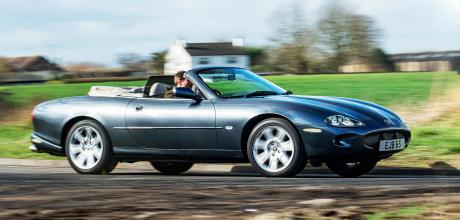1997 Jaguar XK8 Convertible X100
Eliot Barden grew up around XK8s – this convertible has been a labour of love.
BOYHOOD AMBITION
WORDS: ANDREW ROBERTS
PHOTOS: GREGORY OWAIN
XK8 RESTORATION
Andrew Roberts shares the story of young owner Eliot Barden and his childhood dream car.
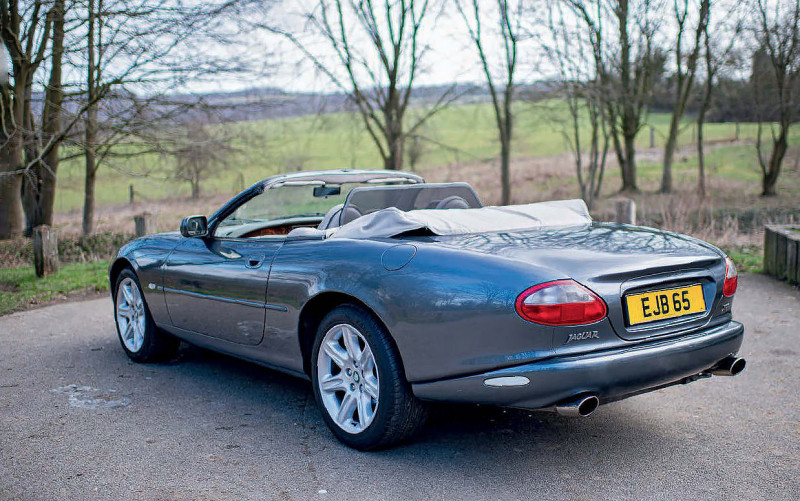
“The ‘sealed for life’ transmission felt sluggish, which often presaged bad news.”
“I became fond of 1990s and early 2000s British car design in my early teens. It is an era that I think designers really got right. The first XK8 I remember was when I was just four years old in 1998. It was a Topaz Gold coupe with Revolver wheels owned by the couple living opposite my home, and it was parked alongside an XJ.
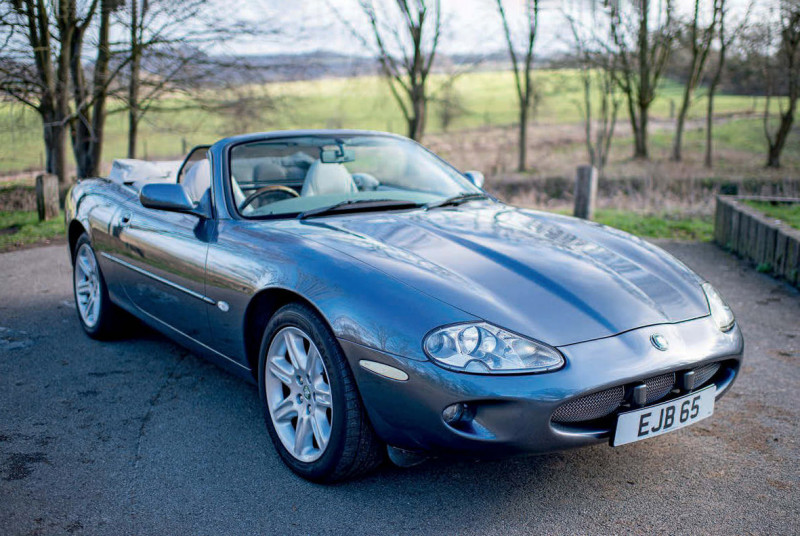
Ever since, Jaguar as a brand has fascinated me, but no other model more so than the X100-series XK8.” The impact of that Jaguar on Eliot Barden was such that 19 years later, he acquired his own very early XK8. Looking at EJB 65 today in its Titanium Grey magnificence, it is almost impossible to believe that it debuted in 1996. To put this date in context, it is as remote from 2023 as the first E-Types would have been in 1988. Or should it be forgotten that the XK8 became the company’s fastest-selling sports model? As with so many fine British cars, the story of ‘Project X100’ was far from straightforward. Jaguar first mooted a replacement for the XJS in 1980, but Ford cancelled Project XJ41 shortly after they acquired the firm in 1989. Two years later, the XJS received a major facelift, and in that same year, work commenced on the X100.

Keith Helfet and Fergus Pollock were responsible for the styling. Jaguar’s design director Geoff Lawson explained to Autocar, “Internally, we had a very strong view that the XK8 ought to be the spiritual offspring of the E-type, with muscular flowing shapes and a much sportier look than the XJS”.
Financial constraints meant the future XK8 employed an XJS floorpan, Lawson reflecting, ‘we wanted to have a more efficient ratio of interior to exterior. So, we made it shorter, but about the same width’. In addition, the boot was large enough to accommodate a set of golf clubs – ideal for the affluent US customer with Country Club membership and with business clients to impress. The rear suspension derived from the X300 XJ, while the major news was the all-new engine. Jaguar initially evaluated a variety of power plants, from straight-six to V12, but market research indicated US and European customers preferred a V8. The XK8 was to be powered by a 290bhp 3996cc, 32-valve unit, married to a five-speed automatic gearbox; there was no manual option. There was also a choice of two interior decors, Classic specification offered soft shades and burr walnut in the manner of a Jaguar saloon, while Sport featured partcloth upholstery and maple veneer for the more youthful buyer. The Barden Jaguar boasts the former. Jaguar launched the XK8 in coupe at the 1996 Geneva Motor Show, the same year of the XJS’s demise.
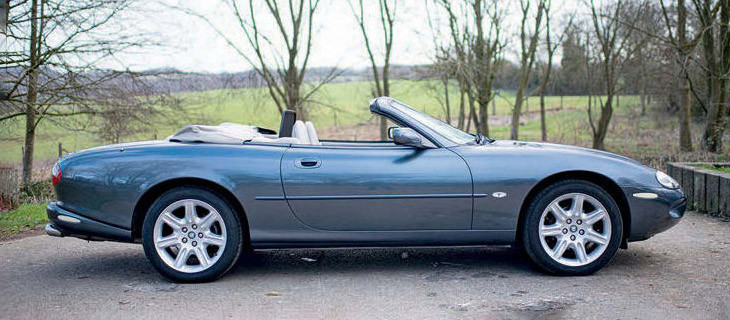
The company’s publicity claimed its ‘powerful flowing lines’ evoked the C-Type, D-Type, E-Type and XJ220 and, rather brilliantly, ‘The Cat is Back’. Meanwhile, some visitors noted a similarity to the DB7 – Ford bought Aston Martin in 1988 — but Lawson told the gathered journalists: “Architecturally the XK8 is similar to the DB7, but the Jaguar’s character is totally different. The Aston Martin is a more sporting car, more masculine, while the Jaguar is more feline. “The new XK8 is a blend of many Jaguars. There is quite a lot of the F-type, which was stillborn, of the XJ220, and there are strong hints of the E-Type.”
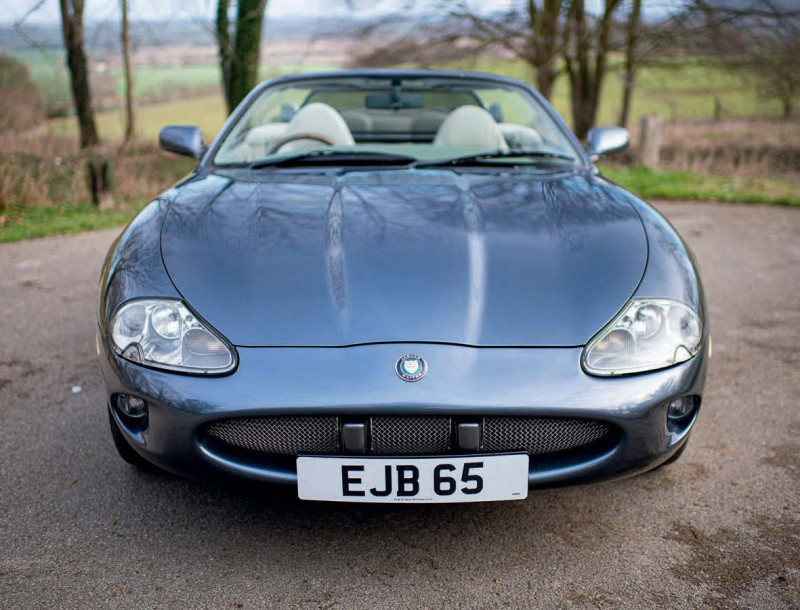
Happily, the motoring press raved about the latest Jaguar. A young chap named Jeremy Clarkson compared it to Blenheim Palace on Top Gear, and when Motor Sport evaluated the XK8 opposite the E31-series BMW 840Ci, they thought it: “not only outperforms and outhandles its rival, but out-rides it too. All at a price saving of over £8,000 (though admittedly some of this is taken up by the BM’s longer list of standard equipment).” Such a report must have been music to the ears of Jaguar dealers worldwide, as was Motor Trend’s description of “a dignified but muted growl”, “0-60- mph acceleration in less than seven seconds” and “an electronically limited top speed of 155 mph”. The XK8 had a different appeal to the BMW – if the latter appeared faintly slab-sided, the former conveyed the marque’s heritage without ever descending into pastiche. Production commenced on 4th June 1996, with sales beginning in October. The convertible followed the coupe by the end of the year. Jaguar allocated 60% of its output to the USA, where the company intended the soft top to be a mass-seller.

Fortunately, the XK8 proved so popular that Jaguar sold 14,929 XK8s in 1997 alone. In the following year, the supercharged XKR made its bow, and both versions received an upgrade in 2002 with 4.2-litre engines.
Production ceased on the 24th of July 2014. For a while afterwards, the XK8 seemed to fall into the depressing state known to so many classic car enthusiasts – ‘Local Newspaper Advertisements Hades’. Their prices were tempting to those who did not realise they were acquiring a ‘bargain’ with the running costs of a specialist vehicle. Fortunately, a new generation of enthusiasts, such as Eliot, appreciated the Jaguar’s innate style and the pitfalls of rushing into ownership. The results could well be a depleted bank balance and being able to address AA and RAC patrols by their first names. In addition to the Jaguar, Eliot also long-craved another famous British marque. As he explains: “I spent a lot of my youth outside, engaging with nature and growing plants. This likely stemmed from a lot of time spent on my Grandparent’s farm in Norfolk while my parents worked nightshifts.
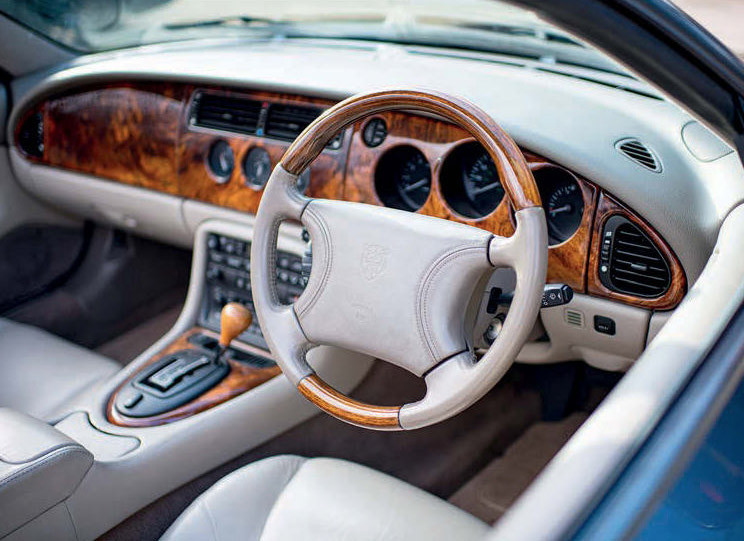
My grandfather had a 1980s Land Rover 110 with which he used to tow a horsebox. The design of these Land-Rovers is timeless perfection in my opinion, and it certainly crossed my mind back then that a Jaguar and Land-Rover would be my perfect two-car garage when I learned to drive”. That Land-Rover eventually took the form of a Defender 90, with Eliot remarking, “In contrast to the luxury leather seats, effortless power and ride comfort in the Jaguar, it is somewhat more agricultural”. Then, six years ago, he and his partner Sophie finally came by his XK8. He recalls: “It had a full Jaguar service history since its production in March 1997. The car had only carried out 64,000 miles at the time, and it had relatively little rust. However, having done my homework, I was immediately aware that I needed to begin working on the Jaguar due to known common faults with the XK8”.
These ‘common faults’ include leaking differentials, malfunctioning remote-control central locking, and electric windows and seats. Furthermore, wise prospective owners investigate corrosion of the rear subframe, sills, floors and bumper areas, tired suspension and steering bushes and pay close attention to evidence of faulty timing gear. In addition, XK8s built before the 18th of August 2000 have Nikasil cylinder bore linings, which could be easily damaged by petrol with a high sulphur content. Fortunately, Eliot’s mechanic told him, “if there are no problems by now, there are unlikely to be any problems in the future, providing I use premium E5 and not E10”.

Eliot was more than aware of these potential issues. When planning his XK8 purchase, he decided: “I specifically wanted an original car that had not been messed around to ensure that the repairs and improvements were my choices from the beginning. I also didn’t want an XK8 with the optional CATS Computerised Active Technology Suspension because of the number of things that can go wrong and because I wanted to enjoy the natural feel of the car”. However, another decision remained — one that confronts so many classic car owners. Should I carry out any repairs and restoration or commission a specialist?
As Mr. Barden reflects: “As much as I would have loved to, I did not carry out the work myself. Instead, I stumbled across G and D Autos — Independent Jaguar Specialists purely by coincidence. I instantly became great friends with Gordon, and not only did he carry out the majority of the work that I asked of him faultlessly, but what he didn’t know about the XK8 model wasn’t really worth knowing”.
The first task was to replace the plastic timing chain tensioners and guides immediately. The water pump and thermostat housing was similarly upgraded with aluminium parts. This was just the start of Eliot’s challenges, but Jaguar enthusiasts are renowned for their fortitude. He remembers: “While the front end was removed, the subframe was dropped and refurbished with all new inner wings, vee mounts and bushes. The same was carried out to the rear whilst fixing the rear bumper brackets and beam at the same time”. Other work included an upgrade of the throttle body and the convertible hood pipes – “to prevent any dreaded ‘green showers’ of hydraulic fluid”.

Eliot found the ‘sealed for life’ transmission felt sluggish, which often presaged bad news. Most XK8 enthusiasts know that problems with the gearbox could mean a blocked filter, deterioration thanks to oil degradation, or – far worse — the need for very expensive work somewhere along the line. Mr. Barden contemplated the first two issues as the cause for the unresponsive box. However, he ultimately opted for: “a full transmission rebuild to ensure the longevity of the vehicle. Lastly, I had some minor areas of rust cut out around the arches and floor where replacement panels were welded in and re-sprayed to prevent it worsening”.
Other rectifications included the wheel sensors and other “little niggles rather than anything major. The steering column had been modified before I bought the XK8, and it looks set for a long life”. In terms of the bodywork upgrades and maintenance, Eliot decided to turn to: “a local company. From the minute I popped in to see Chris at Finishline UK, we instantly got on. I was confident that I would have his team carry out the work. We now also regularly keep in touch socially, regularly updating me on how the plants in his garden are growing and what turf maintenance he is carrying out on his perfect lawn. In addition, every time Gordon sees the car at his workshop, he provides me with a full report on the vehicle, physically showing me any faults. This gives me peace of mind that the XK8 will not only be reliable but will perform optimally until he next sees it. Better still, he is just an all-around great guy, always with something interesting to say, and nothing is ever too much trouble.”
The result was a Jaguar that more than lived up to the brochure’s promise of ‘incomparable comfort and control’ and ‘every aspect is driven by performance’. The decision as to the amount of use for a classic car is a very personal one and Eliot and Sophie believe in regularly driving their fleet. Eliot observes ‘We now travel around 12,000 miles annually in the Defender to and from work and around 6000 in the XK8, mainly on weekends and holidays. Last year we drove the Highlands and islands of Scotland, all told covering 3,350 miles in the Jaguar over the course of two weeks, where it performed faultlessly’.
It virtually goes without saying that Sophie and Eliot have no intention of swapping the XK8 or the TD5 for modern alternatives. Their philosophy is ‘restoring and maintaining cars is a far better way of reducing our personal environmental impact. We believe the continual upgrading of vehicles with a fashion-like mentality cannot be sustainable. The resources used when producing a new vehicle or battery cell and their disposal at the end of life cannot be carbon neutral. Embodied carbon is, in our opinion, vital to maintaining even if technology improves. Both vehicles have real felt personalities, and we endeavour to keep them for as long as we possibly can’.
And both members of the fleet represent a swansong for their respective manufacturers. In Eliot’s words: “Unless mistaken, I believe that the TD5 unit in the Land Rover was the last total in-house engine made by Land Rover, produced in the UK. Likewise, the AJV8 in the Jaguar was the last totally in-house Jaguar-developed V8. These were two the last of the old school engineered British design and manufacture, a principal and mentality that Sophie and I are keen to adhere to. The combined mileage of our cars is well over the distance from the Earth to the moon, and with a combined age of nearly 50 years, we hope they will give us the same again in active service. Our XK8 and Defender 90 have been rolling projects that we have used every day whilst continually improving and future proofing them for the years ahead”.
Eliot summarises the experience of becoming XK8 and Land-Rover custodians thus: “After six years of ownership, we can now say that we have no regrets about meeting our heroes. In almost every way, the versatility and practicality these cars offer a 28-year-old couple is unquestionably idyllic. Not to mention the pride and enjoyment we have owning these vehicles which every single day make us smile”.
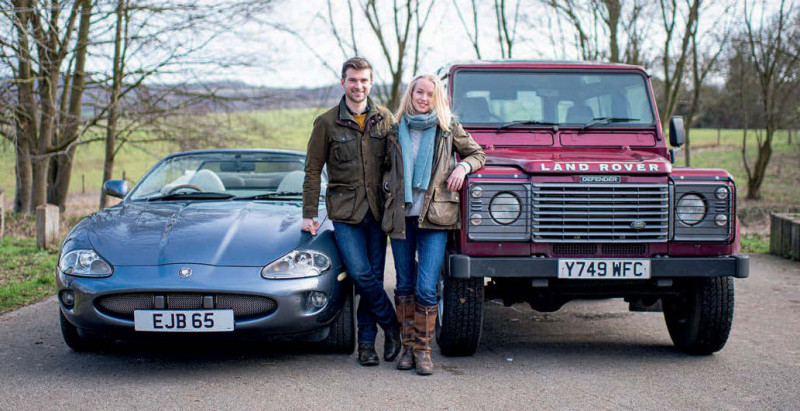
Naturally, the XK8 turns heads wherever it roams. Equally importantly, Eliot represents a generation of enthusiasts who does not believe time ceased in 1974 with the demise of the E-Type or in 1996 with the last of the XJS. To him, and many other devotees, the XK8 is a vital chapter in Jaguar’s story, one that is worthy of appreciation and respect. And always to be enjoyed.
WITH THANKS TO: Eliot Barden
“After six years of ownership, we can now say that we have no regrets about meeting our heroes.”
TECHNICAL DATA 1997 Jaguar XK8 Convertible X100
- ENGINE: 3996cc V8
- MAX POWER: 290bhp
- MAX TORQUE: 290lb ft
- TRANSMISSION: 5-speed automatic
- SUSPENSION: Front — Fully independent with twin wishbones. Coil springs with telescopic dampers. Anti-dive geometry to provide longitudinal stability under heavy braking. Anti-roll bar. Rear — independent with lower wishbones and driveshafts acting as upper links. Coil springs.
- ACCELERATION 0-60 MPH: 6.7 secs
- TOP SPEED: 155mph
- ECONOMY: 24mpg
- WEIGHT: 1797kg
“Architecturally the XK8 is similar to the DB7, but the Jaguar’s character is totally different.”


